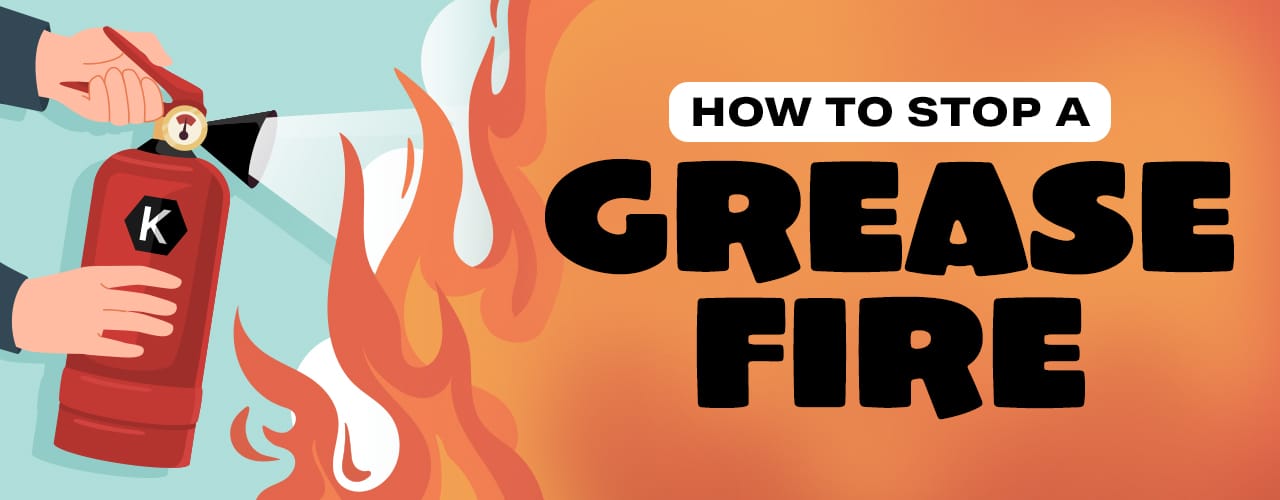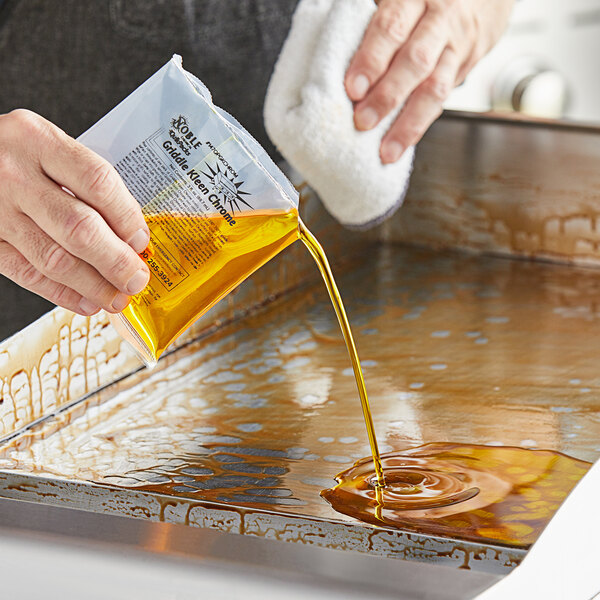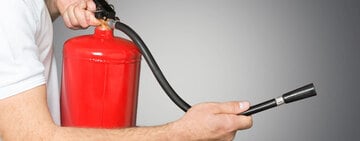
Grease fires, classified as Class K fires, are among the most common kitchen fires and can become hazardous quickly due to their fast-spreading nature. These fires occur when cooking oils or fats overheat and ignite, often leading to devastating damage if your staff isn’t trained on proper fire safety protocols. Continue reading to learn the steps for extinguishing a grease fire, how one starts, and how to prevent one from happening.
Steps for Extinguishing a Grease Fire
A commercial hood system with built-in fire suppression is required in any commercial kitchen where grease-producing cooking equipment is used. However, it is still beneficial for all back-of-house staff to know how to extinguish a grease fire. To stop a fire, it is crucial to eliminate the heat source, fuel, and oxygen that it needs to ignite. We'll walk you through the steps to extinguish a small grease fire in your kitchen and provide tips on preventing the fire from spreading.

- Turn off the heat source. Turn off the piece of equipment immediately to prevent the fire from escalating.
- Cut off the oxygen supply. Cover the flames with a metal lid or baking sheet to starve the fire of oxygen. To keep your hands and arms protected, use heavy-duty heat-resistant tongs instead of an oven mitt to place the lid or pan over the fire. If the fire is in the oven, keep the oven door closed.
- Use baking soda or salt. Pour baking soda or salt to smother the fire in a pan. Baking soda releases carbon dioxide gas when heated, which helps to smother the flames by displacing oxygen. Salt works by drawing heat away from the fire and forming a crust over the flames, cutting off the oxygen supply and smothering the fire. Large quantities of either ingredient are needed, so these methods should only be used on small, contained fires and may not be effective for larger or more severe fires.
- Use a Class K fire extinguisher. Utilize a Class K fire extinguisher specifically designed for kitchen fires to put out the flames. They contain a wet chemical agent specifically formulated to combat fires involving cooking oils, fats, and grease, making them an essential safety tool in any commercial kitchen setting.
- Call 9-1-1. In case the fire cannot be controlled, evacuate the area and call 9-1-1 for professional assistance.
How Do Grease Fires Start?
Grease fires start when cooking oil becomes too hot, often because it is left unattended. During cooking, oils will begin to smoke and eventually catch fire. These signals give staff plenty of warning signs to react and turn down the heat or take the pot off the burner. As long as your staff is attentive and focused, grease fires are avoidable, but sometimes kitchens get hectic during peak times and accidents happen.
Common Grease Fire Mistakes
Although there is a set way to respond to grease fires, there are still many misconceptions and myths surrounding how to deal with one. Many of these misconceptions make grease fires worse and spiral out of control. Here are some of the most common grease fire mistakes that your staff should know to avoid:
- Water on grease fire: Water and oil do not mix, meaning that water will only cause the oil to splash and the fire to spread faster. When water comes into contact with hot oil, it rapidly turns to steam, which can cause a very powerful flare-up and send burning oil flying in all directions.
- Flour on grease fire: Flour is easily ignitable and combustible at high temperatures, quickly making a fire worse.
- Baking powder on grease fire: Many people confuse baking soda with baking powder, but the two are not chemically the same. Much like flour, baking powder will make a grease fire much worse.
Tips for Avoiding a Grease Fire
Here are some tips to help you avoid a grease fire altogether, or to prevent a small fire from escalating into a large, uncontrollable blaze. By following these precautions, you can significantly reduce the risk of a dangerous kitchen fire and keep your cooking area safe.

- Know your cooking oil’s or fat’s smoke point. Use cooking oil with a high smoke point to be sure it can handle high-heat cooking applications. For example, avoid using extra virgin olive oil, which has a low smoke point, to sear a steak in a cast iron pan.
- Slowly heat oil or fat to the desired temperature. Rapidly heating oil can cause oil splatters, smoking, and burning. It can also make it hard to maintain a consistent temperature during cooking, affecting the quality of your food.
- Turn off or lower the burner if the oil gets too hot. If you notice the oil smoking or starting to splatter, immediately turn off the burner or reduce the heat to prevent it from reaching its flash point.
- Gently place food into the pan or fryer. Carefully add food to the hot oil to avoid splattering and minimize the risk of burns or flare-ups.
- Do not keep highly flammable items near cooking equipment. Store flammable items such as cooking oil, alcohol, chemicals, and paper towels away from the cooking area to reduce the risk of accidental fires.
- Keep lids for your pans within reach. In case of a small grease fire, quickly covering the pan with a lid can help smother the flames by cutting off the oxygen supply.
- Keep a fire extinguisher within reach. It is essential to have a Class K fire extinguisher nearby when cooking with grease to promptly address any fires that may occur. Train your staff on how to use the fire extinguisher before an emergency arises.
- Don’t leave your equipment unattended while in use. Ensure there is always someone stationed at your cooking equipment when heating oil and cooking food. Leaving grease or oil on a hot surface unattended is one of the most common ways kitchen fires start.
- Install a type 1 hood over your grease- and smoke-producing equipment. Also known as grease hoods, Type I kitchen hoods remove heat, smoke, and airborne grease. These hoods are found over appliances such as fryers, broilers, grills, and ovens. Be sure to adhere to all local commercial kitchen hood code requirements when installing.
- Install a fire suppression system. All commercial appliances under a Type I hood must have an approved automatic fire suppression system. Activated when they detect fire or excessively high heat and include spray heads that discharge fire suppression chemicals into the vent hood, grease filters, and over the equipment in the cook line to put out the fire and prevent a restart.
- Implement fire safety training for employees. Staff should be instructed on fire safety protocols, from learning how to prevent fires and the common fire hazards to avoid to how to respond to the different types of fires calmly and efficiently.
- Regularly clean your cooking equipment. Clean and wipe down your cooking equipment at the end of each day to prevent F.O.G. (fats, oils, and grease) buildup.
When faced with a grease fire in a commercial kitchen, it is crucial to act quickly and effectively to prevent the situation from escalating. By following the proper steps for extinguishing a grease fire, you can ensure the safety of yourself, your staff, and your establishment. Remember to never use water to extinguish a grease fire, as it can cause the flames to spread and make the situation more dangerous. Instead, use a fire extinguisher specifically designed for grease fires or smother the flames with a metal lid or baking soda. By being prepared and knowing how to respond to a grease fire, you can protect your kitchen, your employees, and your customers from harm.





